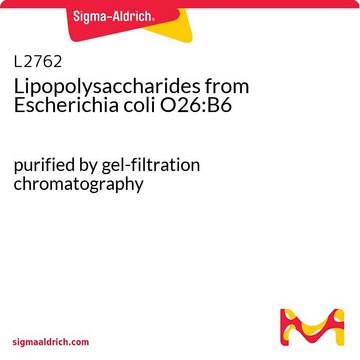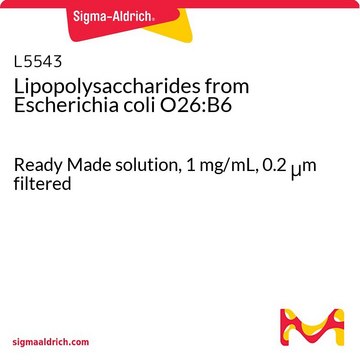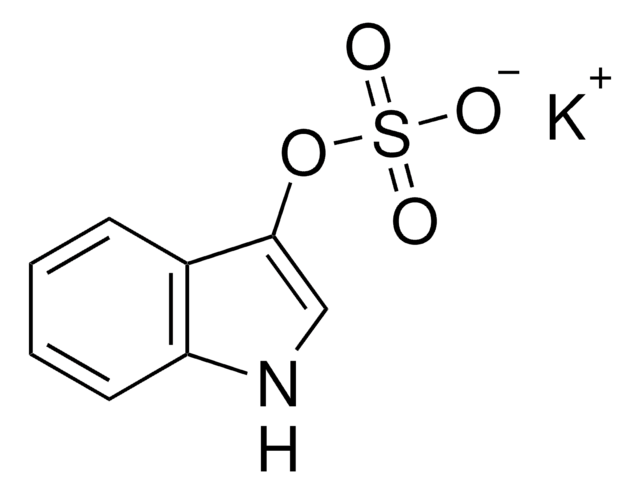L8274
Lipopolysaccharides from Escherichia coli O26:B6
≥10,000 EU/mg, purified by phenol extraction
Synonym(s):
LPS
Sign Into View Organizational & Contract Pricing
All Photos(3)
About This Item
Recommended Products
biological source
Escherichia coli (O26:B6)
Quality Level
form
lyophilized powder
specific activity
≥10,000 EU/mg
purified by
phenol extraction
impurities
<3% Protein (Lowry)
color
white to faint yellow
solubility
water: soluble
shipped in
ambient
storage temp.
2-8°C
Looking for similar products? Visit Product Comparison Guide
General description
This product is phenol extract from E. coli serotype O26:B6. The source strain is ATCC 12795. LPS from serotype 026:B6 is the only LPS from E. coli which exhibits short chain-length behavior on SDS-PAGE. The short chain-length of this LPS is closer to that of the mutant rough strain LPS. This LPS serotype has been used at 1 ug/ml to stimulate neutrophils.
Application
Lipopolysaccharides (LPSs) are characteristic components of the cell wall of Gram-negative bacteria. LPS and its lipid A moiety stimulate cells of the innate immune system by the Toll-like receptor 4 (TLR4), a member of the Toll-like receptor protein family, which recognizes common pathogen-associated molecular-patterns (PAMPs).
Biochem/physiol Actions
Lipopolysaccharides (LPS) are localized in the outer layer of the membrane and are, in noncapsulated strains, exposed on the cell surface. They contribute to the integrity of the outer membrane, and protect the cell against the action of bile salts and lipophilic antibiotics.
Preparation Note
The product is soluble in water (5 mg/ml) or cell culture medium (1 mg/ml) yielding a hazy, faint yellow solution. A more concentrated, though still hazy, solution (20 mg/ml) has been achieved in aqueous saline after vortexing and warming to 70-80 oC. Lipopolysaccharides are molecules that form micelles in every solvent. Hazy solutions are observed in water and phosphate buffered saline. Organic solvents do not give clearer solutions. Methanol yields a turbid suspension with floaters, while water yields a homogeneously hazy solution.
Other Notes
To gain a comprehensive understanding of our extensive range of Lipopolysaccharides for your research, we encourage you to visit our Carbohydrates Category page.
related product
Product No.
Description
Pricing
Signal Word
Danger
Hazard Statements
Precautionary Statements
Hazard Classifications
Acute Tox. 2 Oral
Storage Class Code
6.1A - Combustible acute toxic Cat. 1 and 2 / very toxic hazardous materials
WGK
WGK 3
Flash Point(F)
Not applicable
Flash Point(C)
Not applicable
Personal Protective Equipment
dust mask type N95 (US), Eyeshields, Gloves
Choose from one of the most recent versions:
Already Own This Product?
Find documentation for the products that you have recently purchased in the Document Library.
Customers Also Viewed
Yvonne Huber et al.
Cell death & disease, 8(6), e2893-e2893 (2017-06-24)
Physical activity confers a broad spectrum of health benefits. Beyond the obvious role in metabolically driven diseases, the role of physical activity in acute liver injury is poorly explored. To study the role of physical activity in acute liver injury
Una Avdic et al.
Frontiers in neurology, 10, 701-701 (2019-07-25)
Non-convulsive status epilepticus (NCSE) is a prolonged epileptic seizure with subtle symptoms that may delay clinical diagnosis. Emerging experimental evidence shows brain pathology and epilepsy development following NCSE. New diagnostic/prognostic tools are therefore needed for earlier and better stratification of
Marie-Anne Mawhin et al.
Cardiovascular research, 114(12), 1656-1666 (2018-05-26)
Both leukotrienes and neutrophils have been linked to plaque destabilization. Despite being evoked, the role of leukotriene B4 (LTB4) in neutrophil recruitment to plaques and the concomitant effects of these two actors on plaque stability remain to be proven. Since
Cheng-Jui Lee et al.
British journal of pharmacology, 146(3), 378-388 (2005-07-19)
Oregonin isolated from Alnus formosana is a diarylheptanoid derivative, which appears to have antioxidative and anti-inflammatory activities. In this study, our data demonstrated inhibitory actions of oregonin on the LPS-induced iNOS protein in RAW264.7 macrophages and BV-2 microglial cells. We
Khandaker Ahtesham Ahmed et al.
The Biochemical journal, 441(2), 719-730 (2011-10-05)
8-Nitro-cGMP (8-nitroguanosine 3',5'-cyclic monophosphate) is a nitrated derivative of cGMP, which can function as a unique electrophilic second messenger involved in regulation of an antioxidant adaptive response in cells. In the present study, we investigated chemical and biochemical regulatory mechanisms
Our team of scientists has experience in all areas of research including Life Science, Material Science, Chemical Synthesis, Chromatography, Analytical and many others.
Contact Technical Service




